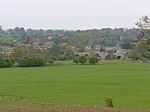Walwick Grange
Country houses in NorthumberlandGrade II* listed buildings in Northumberland

Walwick Grange is a privately owned 18th-century country house ( now a farmhouse) situated on the bank of the River North Tyne close to Hadrian's Wall at Warden, Northumberland. It is a Grade II* listed building. Walwick was the seat of the Errington family from the mid 16th century. The three-storey five-bayed house was built, probably on the site of a medieval tower house, in the early 18th century. William Errington of Walwick Grange was High Sheriff of Northumberland in 1739. His son John built a new house at Chesters (Humshaugh) in the 1770s. Medieval fishponds nearby have Scheduled Ancient Monument status.
Excerpt from the Wikipedia article Walwick Grange (License: CC BY-SA 3.0, Authors, Images).Walwick Grange
B6319,
Geographical coordinates (GPS) Address Nearby Places Show on map
Geographical coordinates (GPS)
| Latitude | Longitude |
|---|---|
| N 55.018 ° | E -2.146 ° |
Address
B6319
NE46 4BQ , Warden
England, United Kingdom
Open on Google Maps








